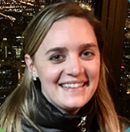IU’s CNS Center Illustrators win Awards!
IU CNS Center Illustrators Win Awards!
August 28, 2024
Two medical illustrators from the Indiana University Cyberinfrastructure for Network Science Center (IU - CNS Center) were recognized for their HRA and HuBMAP work, respectively, at the 2024 Association of Medical Illustrators (AMI) Awards during their annual conference in Rochester, NY. Animation created for the HRA by another IU - CNS Center medical illustrator was also recognized at the Pixie Awards.
Rachel Bajema earned an Award of Excellence for the "Human Reference Atlas Functional Tissue Unit (FTU) Explorer." This open source project orients users in a 2-D environment to explore cell type populations by biomarker. The data are organized by FTU, defined as the smallest group of cells that performs a unique physiological function, replicated within an organ. The Human Reference Altas (HRA) FTU Explorer features experimental datasets from HuBMAP and three other consortia. Each illustration was created in partnership with organ-level subject matter experts.

This project is part of the HRA, a comprehensive, high-resolution, three-dimensional, multi-scale atlas of anatomical structures and cells in the healthy human body. Users may download versions of the illustrations along with connected data sets and metadata. For the past 15 years, Rachel has worked with scientists, researchers, advertising agencies, pharmaceutical companies, and medical legal clients on medical illustration and animation projects. See Rachel’s award-winning interactive illustrations.

Heidi Schlehlein received an Award of Merit for the 3D Nature cover, "Body Image." This image was created for the HuBMAP project and selected as the cover image for the project’s Nature publication package. The goal of the project is to develop an open and global platform to map healthy cells in the human body. The proper functioning of human organs and tissues is dependent on the interaction, spatial organization, and specialization of all our cells. HuBMAP provides the framework necessary to construct tools, resources, and cell atlases.
These tools and resources determine how relationships between cells can affect the health of an individual. This image is meant to draw attention to all aspects of the HuMBAP project and highlight its framework nature, represented by the gridwork on the organs. The organs are filled with cellular images contributed by tissue mapping centers in the HuBMAP consortium. Working as a medical modeler, Heidi has created anatomical models manufactured and sold worldwide. Later she branched out into freelance graphic and digital design, working for several ad agencies and UIC. Through her own company, SciSculpt, Heidi also makes 3D printed medical models for researchers and pharmaceutical companies. See Heidi’s award-winning image.
Ushma Patel won a Pixie Award and an Award of Merit in the categories of animation, film short, and women filmmakers, in the best shorts competition for her animation "Human Reference Atlas: VCCF." Seventeen international scientific consortia, representing more than 1,000 researchers, collaborate on the ambitious Human Reference Atlas (HRA) project, which is building a comprehensive map of the trillions of cells in the human body. An innovative aspect of the HRA is that it uses pathways formed by blood vessels throughout the body as a kind of roadmap, known as the Vasculature Common Coordinate Framework (VCCF).

For example, like a truck driver using GPS to follow streets to a destination, cells flow through blood vessels to deliver oxygen and nutrients to all parts of the body. The primary goal of this video is to distill the science behind the HRA by presenting an overview of how biomedical researchers are using blood vessels to create a CCF of all cells in the human body. Secondary goals include sparking curiosity both within the scientific community as well as the general public. Ushma is a freelance biomedical animator, designer, and art director who collaborates with researchers, animation studios, medical education agencies, and other clients to create animations, 3D images, and design solutions. She previously worked as a graphic designer, teaching assistant, and research assistant. See Ushma’s award-winning and visually stunning animation.
Note: Thanks to Nicole Johnson of the Cyberinfrastructure for Network Science Center at IU for providing biographical details, photos, and other information for this article.
